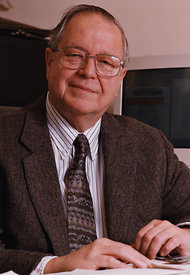-
(b.) -1935 December 03(d.)2011 August 26
Bio/Description
An American computer scientist, a noted researcher in computational complexity theory and database theory, he was a target of the Unabomber. Born in St. Louis, Missouri, his father, Carl H. Fischer, became a professor of Actuarial Mathematics at the University of Michigan in 1941, and the family moved to Ann Arbor, Michigan where he grew up. He went to the University of Michigan, receiving a Bachelor's degree in 1957 and an M.B.A. degree in 1958. He went on to graduate studies at the Massachusetts Institute of Technology, earning a Ph.D. in 1962 under the supervision of Hartley Rogers, Jr., with a thesis on the subject of recursion theory. After receiving his Ph.D. he joined the faculty of Harvard University as an Assistant Professor of Applied Mathematics. His students at Harvard included Albert R. Meyer, through whom came over 250 academic descendants, as well as noted computer scientists Dennis Ritchie and Arnold L. Rosenberg. In 1965, he moved to a tenured position as Associate Professor of Computer Science at Cornell University, and again in 1968 he moved to the University of Waterloo where he became a Professor of Applied Analysis and Computer Science. At Waterloo, he was department Chair from 1972 to 1974. He then moved to Pennsylvania State University in 1974, where he headed the Computer Science department, and moved again to Vanderbilt University as department Chair in 1980. He taught at Vanderbilt for 18 years, and was Chair for 15 years. He retired in 1998, and died of stomach cancer on August 26, 2011 in Rockville, Maryland. He became a Fellow of the Society of Actuaries as his father had done. His second wife, Charlotte Froese Fischer, is also a Computer Science professor at Vanderbilt University, and his brother, Michael J. Fischer, is a Computer Science professor at Yale University. His thesis research concerned the effects of different models of computation on the efficiency of solving problems. For instance, he showed how to generate the sequence of prime numbers using a one-dimensional cellular automaton, based on earlier solutions to the firing squad synchronization problem, and his work in this area set the foundation for much later work on parallel algorithms. With Meyer and Rosenberg, he performed influential early research on counter machines, showing that they obeyed time hierarchy and space hierarchy theorems analogous to those for Turing machines. He was an early leader in the field of computational complexity, and helped establish theoretical computer science as a discipline separate from mathematics and electrical engineering. He was the first Chair of SIGACT, the Special Interest Group on Algorithms and Computation Theory of the Association for Computing Machinery, which he founded in 1968. He also founded the annual Symposium on Theory of Computing, which together with the Symposium on Foundations of Computer Science is one of the two flagship conferences in theoretical computer science, and he served five times as Chair of the conference. In the 1980s, his research interests shifted to database theory. His research in that area included the study of the semantics of databases, metadata, and incomplete information. He did important work defining the nested relational model of databases, in which the values in the cells of a relational database may themselves be relations, and his work on the mathematical foundations of database query languages became central to the databases now used by major web servers worldwide. He was also an expert in information systems and their use by educational institutions. In 1982, he was a victim of Ted Kaczynski, known as the Unabomber, who sent a fifth of his mail bombs to him, at his Penn State address; it was forwarded to Vanderbilt, where it was opened on May 5 by his secretary, Janet Smith, who was hospitalized for three weeks after the attack. Ted Kaczynski, was a graduate student of mathematics at the University of Michigan, where his father was a professor. He claimed not to have ever met Kaczynski, and speculated that he was targeted because he had moved from pure mathematics to more applied research areas. Kaczynski was not apprehended until 1996, by which time the statute of limitations on the 1982 bombing had expired, so he was never prosecuted for the crime.
-
Date of Birth:
1935 December 03 -
Date of Death:
2011 August 26 -
Noted For:
His work In the 1980s on the mathematical foundations of database query languages became central to the databases now used by major web servers worldwide -
Category of Achievement:
-
More Info:


